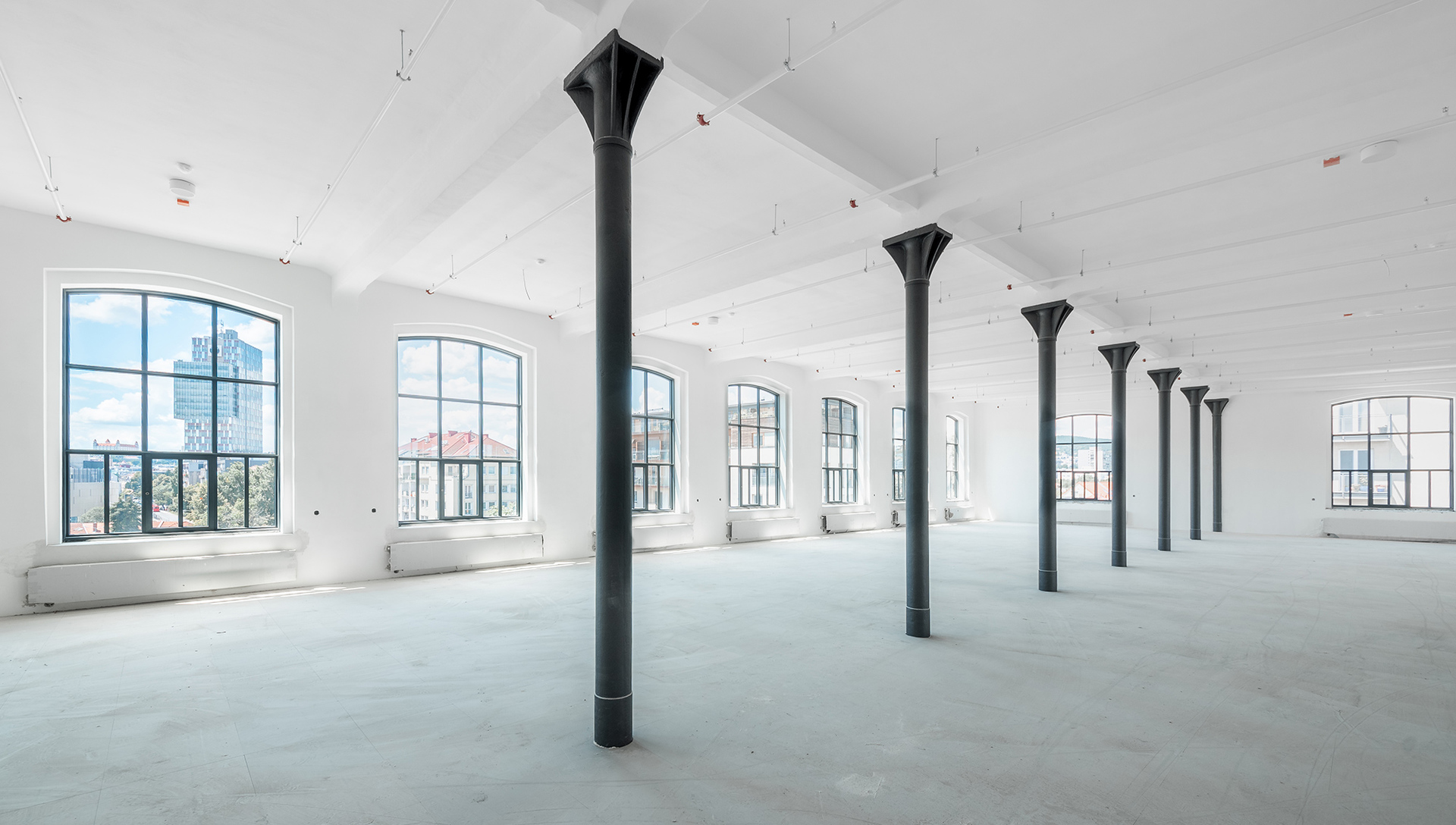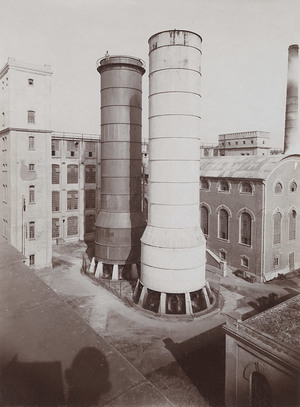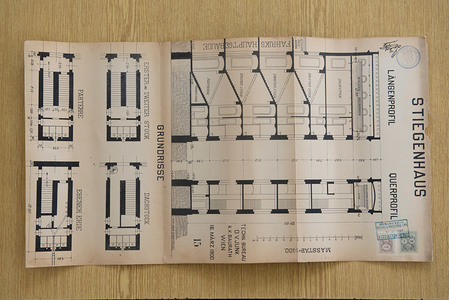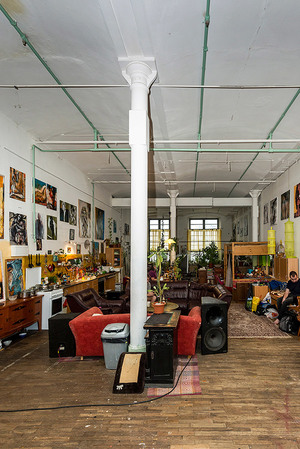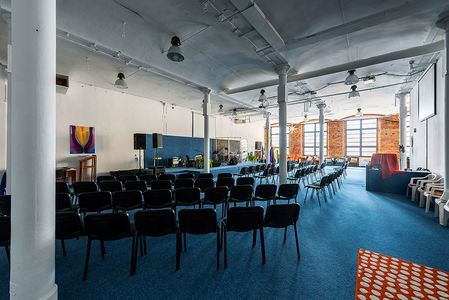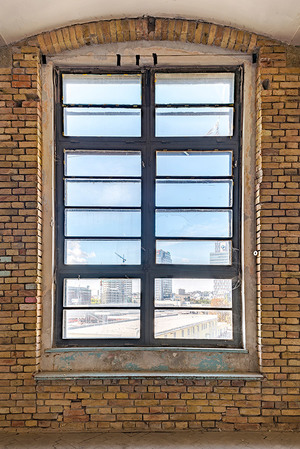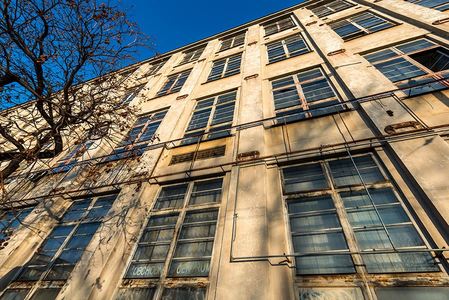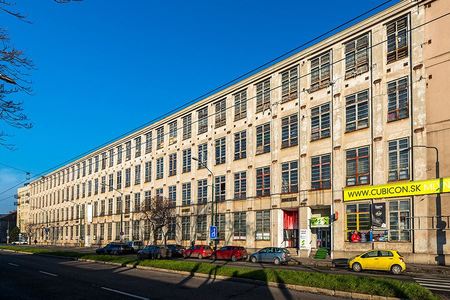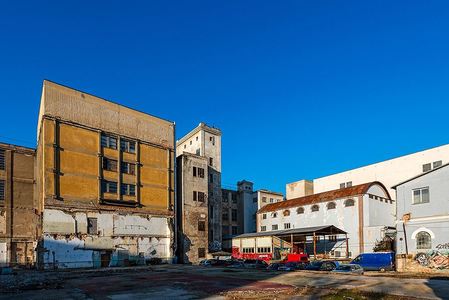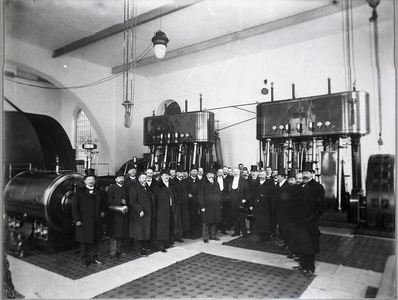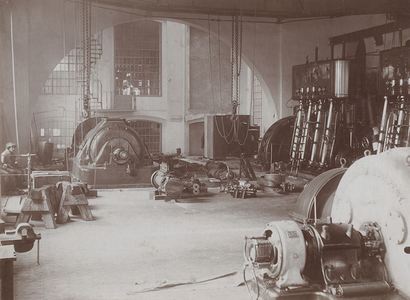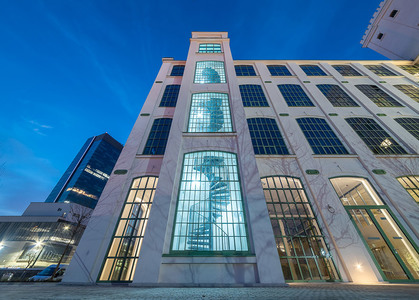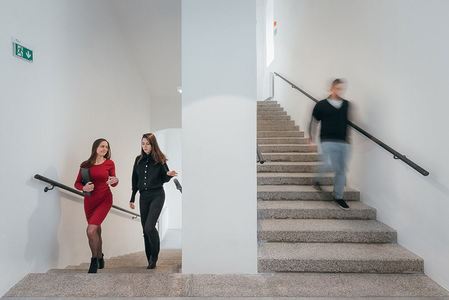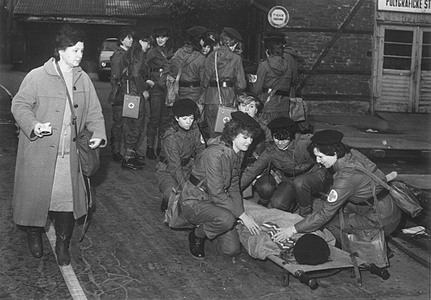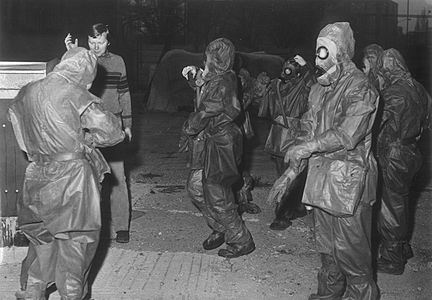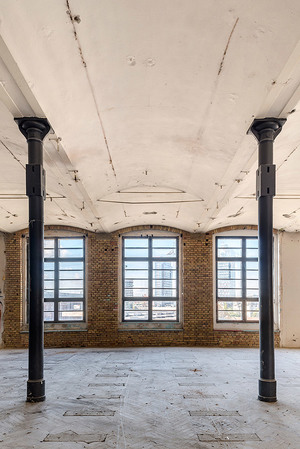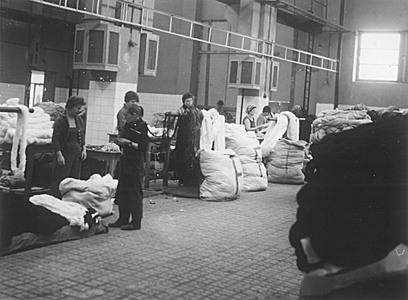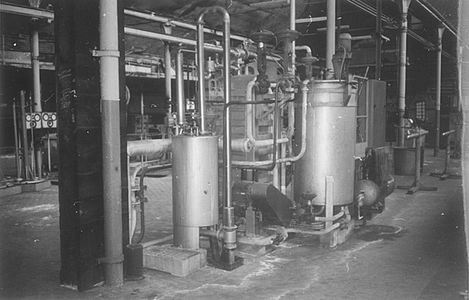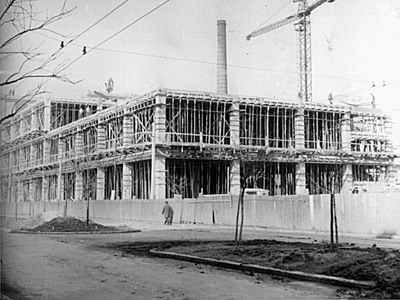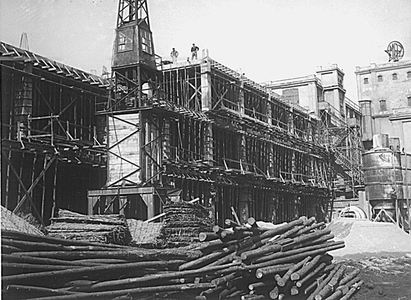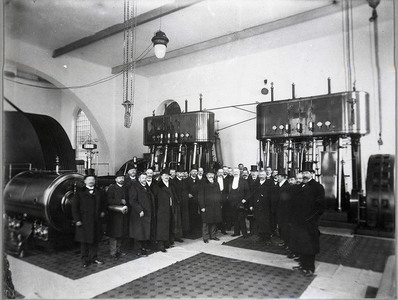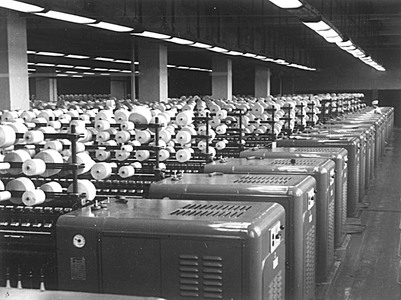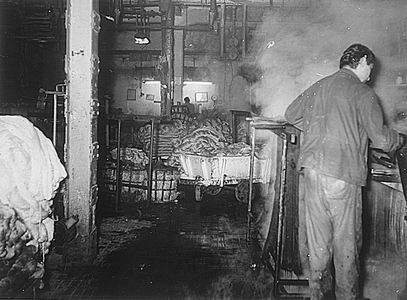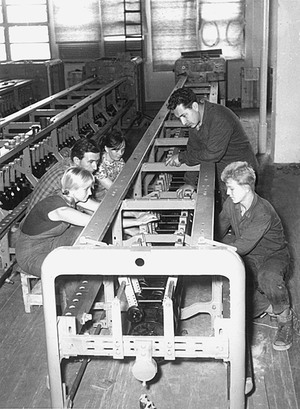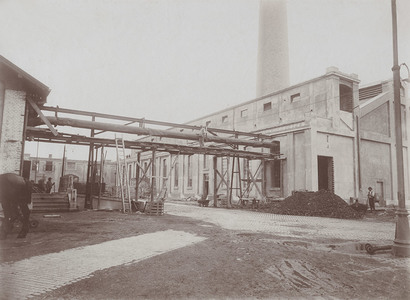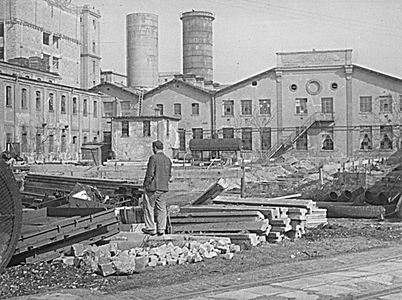History and interesting facts about Pradiareň 1900
The Pradiareň building is part of the area of the former Uhorská cvernová továreň (Hungarian thread factory), which was founded in 1900 by the foreign firms Salcher & Richter and J. & P. Coats. It was designed by Viennese architects D. V. Junk and K. K. Baurath. The current name of the district, Zwirn, is based on the original name of the Uhorská cvernová továreň (Zwirnfabrik, Magyar czérnagyár), and its construction took place in several stages. You can read about how special this building really is below.

a factory with the participation of Austrian and Scottish capital,
a project from Viennese architect
D. V. Junek
1905
the Pradiareň building itself was realized in 2 stages
(993 employees)
(2,500 employees)
of the factory)
as a national cultural monument
In 1902, the southern part of the Pradiareň was built together with the adjoining Silocentrála (energy center) building, which served as the energy center of the entire area. Around 1905, the success of the Uhorská cvernová továreň (Hungarian thread factory) led to the expansion of the original building by adding the northern part. The most modern machines, technologies mastered at a very high level and the resulting product, which was shipped out to various parts of the monarchy and abroad, became the decisive reason for the addition of the third floor to the Pradiareň in 1912. The technological issue of transporting material within the building was solved in 1920 by the addition of three freight elevator shafts on the eastern facade. At the turn of the 20th century, the building represented the artistic and structural pinnacle of the period's industrial architecture. Construction modifications in the second half of the 20th century were only utilitarian interventions that had a rather negative impact on the quality of the original architecture.
In the Pradiareň’s entrance hall on the black perforated wall, you will find a period photograph of two cooling towers, which were located in the immediate vicinity of the engine room. They served as a cooling element in the steam production process. Together with the chimney, the towers formed a natural dominant feature of the factory and its surroundings. We can find this visual perception, for example, in the form of an emblematic display of the factory's identity on later trademark logos from the period after 1918.
From the year 2000, after the end of production, the building was transformed into a creative and exhibition space and was home to creative studios.
In 2006 and 2007, painters, photographers, architects, filmmakers and designers gradually settled in the premises of the former Pradiareň factory. It housed more than 30 studios. Instead of threads, Cvernovka (the thread factory) began to produce works that the world could enjoy in London's Tate Modern, at the Venice Biennale and at many other exhibitions and markets of world importance. It spontaneously became one of the first community creative centers despite the lack of interest from the local government and investors. At the same time, four members of the creative community initiated the establishment of the Cvernovka Foundation for the purpose of improving the cultural, social and material value of the former industrial area of the Cvernová továreň (the thread factory). Gradually, its closed community began to open up more to the public when various community civic associations, a bookstore, a coworking center and a gallery set up there. After negotiations with the investor in 2016, the creative community left the building and moved to new premises in the area of a former chemical industrial school.
The dominant feature of the reception area is the black perforated tile, on which you will find a photo from the period the creative studios were in Cvernovka (the thread factory). The author of the photo is Šymon Kliman.
Throughout the Pradiareň you will find a total of 505 windows with 78 shape variations. The windows on the ground floor were uncovered during the reconstruction of the building and were restored and reinserted.
80 windows underwent refurbishment and were reinserted. The remaining 425 windows copy the original design from 1900. The windows were originally round, but were later changed to a square shape when the facade was repaired. During the revitalization from 2018 to 2020, the investor preserved some of the windows, restored them and changed them back to their original round shape. The rest of the windows are new and made from aluminum with insulating double glazing and a metal coating to protect against sunlight. They were made based on the original design from 1920.
Thanks to a sensitive reconstruction process, the original art deco decoration on the ground floor columns of the Pradiareň was partially restored. The use of artistic elements in architecture is a characteristic feature of industrial buildings from the early 20th century.
Other significant historical elements include preserved and restored steel windows with their typical multiple panes of glass and inventive opening system, as well as cast-iron columns and an Art Nouveau steel spiral staircase. The restored exterior of the Pradiareň is characterized by a white facade with window panels in the original green color. The original architectural elements, arched window openings and the historic shape of the attic, were restored on the facade. The steel columns in the Silocentrála, the steel entrance portals and the new reinforced concrete staircase in the connecting passage of the Silocentrála (energy center) are significant new design elements. The original combination of coarse-grained plaster and brick masonry work from 1902 is preserved on the Silocentrála building. New entrances and window openings on the northern and eastern facades that are characteristically framed by sheets of steel are significant architectural elements. This national cultural monument has undergone a demanding reconstruction process under the direction of the BOUDA MASÁR architectural studio. Despite all the necessary adaptations to allow for new functions in the building, its final form really lets the period architecture and the structural craft stand out.
On the black perforated tile on the right of the entrance hall, you will find a period photograph from T. Manin's private archive. It is a picture of the northern part of the Pradiareň, and the area that is bordered by today's Páričková and Záhradnícka Streets is in the background.
The Silocentrála (energy center) was the heart of the whole factory, as steam engines, main distributors, auxiliary operations and control rooms were located there. Although the building is not officially a cultural monument, it has been preserved beyond the scope of monument protection. During the reconstruction works, the Silocentrála building also underwent a detailed renovation, and its original appearance was restored.
The original look from 1902 with a combination of coarse-grained plaster and articles of brick masonry is preserved on the Silocentrála building. It is built perpendicular to the eastern facade of the Pradiareň and is joined to it by a connecting passage. It has three storeys and an arched roof. The biggest change in the Silocentrála (energy center) is the replacement of the original passage connecting it to the Pradiareň with a transparent glass structure with a new staircase that connects all the levels. Significant elements also include a partially suspended platform that was put in the space that was the original technological hall.
The oldest part of the Pradiareň building is a stone staircase that was built in 1902. Thanks to careful reconstruction, it has been preserved along with the railing. At that time, the staircase was the only way to access the higher floors. Until 1920, it also served to transport material.
Along with the construction of the Pradiareň building, a central stair tower was built at the location of the central axis of the eastern facade. Its internal layout became a decisive solution to the issue of connecting the individual floors of the main building thanks to the construction of a double flight staircase. The stair treads were made of terrazzo, and the landings had a ceramic floor. The walls of the premises were covered with cement plaster, which was smoothed with felt, and white lime paint. The transport of raw cotton, the distribution of semi-finished products and the transfer of finished materials from the individual floors to other operating parts of the Cvernová factory (the thread factory) were handled by freight elevators, which were situated as internal installations on the north and south walls of the hall.
Women from Slovakia and abroad worked at the Pradiareň. Therefore, from 1952 – 1991 the factory was called the International Women's Day Factory.
On March 8, 1952, on International Women's Day, the Cvernovka and Danubius factories merged and were ceremoniously renamed as the International Women's Day Factory. From the original 640 employees, the factory's staff grew to more than 2,500 employees over the course of half a century, and up to 3/4 of them were women. It was the golden age of the company, and the factory processed cotton from Soviet Central Asia and produced products of all kinds under the capitalist brand Squirrell. The factory reached peak production in the 1960s, and it eventually went bankrupt thirty years later when the supply of steam was cut off. On January 8, 1991, the International Women’s Day Factory was renamed the Bratislavská cvernová factory (Bratislava thread company), a joint-stock company.
On the last wall of the black perforated paneling in the entrance hall, you will find a period photograph from the time of the International Women's Day Factory.
The Pradiareň building, also called the "Industrial Palace", was the most imposing structure of the entire factory. Its unique construction consists of one concrete and 403 cast iron columns made in the Budapest foundries Schlick and Wagner.
The construction system of the Pradiareň was made completely based on the size and performance of the machines that were placed in it. The building’s structure consists of cast iron columns together with rail beams into which vaults were built. The height of the columns is up to 5,100 mm, and their diameter is 250 mm. It is a unique supporting structure found only in Art Nouveau buildings. Characteristic features of the building such as the facade and shapes used were already part of the unmistakable brand of the factory at the time of the Pradiareň’s establishment. In 1910, it was already the largest industrial enterprise in Bratislava. 993 people worked there, of which 640 were women. There were 22,000 spindles spinning on the machines at that time. At the turn of the 20th century, the building represented the artistic and structural pinnacle of the period's industrial architecture.
The first floor of the Pradiareň was where cotton was brought from the ground floor by an elevator on the south side after initial processing. Subsequently, it passed through fly frames, which adjusted the thickness of the fibers.
The cotton yarn that passed through the fly frames was still raw and had not yet been given a metric number. In order to get one, it had to be twisted, and that’s exactly what ring spinning machines were used for. Subsequently, the yarn was sent down the line for further processing, where there were once again machines to give the yarn the necessary twists. Upon the completion of these operations, the yarn was ready for tanning, which got rid of the fibrous hairs. 22,000 spinning spindles and 20,000 thread spindles were used to produce threads and yarns. Cvernovka (the thread factory) produced various kinds of yarns and threads, which were mostly for the domestic market, and up to 20,000 balls of yarn per year. The processing of rare cotton from Uzbekistan and Tajikistan and various colored threads ensured its leading position on the European market.
The Silocentrála (energy center) was originally designed for a steam engine that would drive machines using gear belts. In 1902, however, a more modern electric technology was implemented. A mezzanine was built into the original hall to take advantage of the space.
An important factor in the operation of the new technological building that impacted the layout of the building was the transport of material. The semi-finished cotton products required constant movement in both horizontal and vertical directions, and therefore in 1920, three freight elevator shafts were built into the eastern facade. On all the floors of the Pradiareň, there were machines powered by transmissions that were driven by a machine in the engine room through sets of cables that were located in the middle of the building. The engine room building joined the Pradiareň in this very place. The engine room was mainly made up of the most modern propulsion machines, which were initially powered by steam. There were two separate cooling towers in the yard in the immediate vicinity of the engine room that served as cooling elements in the steam production process. The towers carried out their function until the boiler room was shut down in 1963, when the entire factory was connected to the city's electricity grid. In 1964, a modern reinforced concrete building, the so-called “etážová budova” (multi-story building), was built next to the Pradiareň. A great expansion and modernization of the Pradiareň took place in the 50s and 60s of the 20th century. In 1958, a dormitory with a capacity of 400 beds, a vocational school and classrooms were built. Three years later, a new factory canteen, which was a part of the dormitory building, also began operating.
The project of the factory and its eight buildings were designed by the Imperial-Royal Construction Adviser and City Building Master from Vienna, David Valentin Junk. The construction and engineering company Pittel & Brausewetter also helped with the project.
Foreign capital and the rich experience of powerful businessmen and owners of several factories from Austria and Great Britain made the establishment of the Pradiareň possible. The original owners of the factory were two companies - the Viennese company Salcher & Richter and the thread production company J. & P. Coats. The company Pittel and Brausewetter also got significantly involved in the construction of the Pradiareň, as it constructed and later designed most of the original buildings. The company began experimenting with the then little-used Portland cement and built a reputation on this know-how. The structure of the Pradiareň consists of 403 cast iron columns, which were made in the Schlick foundry in Budapest, together with rail beams into which the vaults were built. The factory machinery was mostly of English origin, but during the Second World War it was supplemented with spinning machines from Switzerland. Many people from Third World countries with whom there were friendly relations worked at the Pradiareň, especially those from Cuba and Vietnam.
Each floor had its own specific characteristics - the architectural design was always based on the layout needs of individual processes. Raw cotton was processed on the ground floor, and the thickness of the fibers was adjusted by machines on the first floor. On the second floor, the yarn was still raw without its metric number, which it obtained on the third floor by being twisted on ring spinning machines.
Raw cotton from various parts of the world arrived at the Pradiareň in heavy bales weighing 250 kilograms that were ready for processing. The whole process of yarn production began on the ground floor, where the initial processing took place. This included such steps as mixing the cotton, fluffing it, winding it on a spool and combing it. The whole production process started by loosening a bale of compressed cotton using a carousel, in which 6 bales of cotton were placed. On its sides were steel reels with sharp spikes that picked cotton from the bale. A strong airflow then blew the loose cotton into the pipeline to other machines. The combing process, where short and long fibers were separated, was important. Up to 20% of it was cotton noils, or in other words, production waste. After the raw cotton went through the initial operations on the ground floor, it reached the second floor thanks to an elevator on the south side. Here it passed through fly frames, which adjusted the thickness of the fibers. The yarn that emerged was still raw and did not yet have a metric number. In order to get one, it had to be twisted, which is what the ring spinning machines on this floor were used for. The fourth floor was used to complete the yarn for further processing, and there were also machines that gave the yarn its necessary twists. Upon the completion of these operations, the yarn was ready for tanning, which stripped off the hairs. The yarn was moved from the Pradiareň to the dye house building. There, it was not only dyed to the desired shade, but also refined using various technological procedures. In the beginning of the factory’s operation, it was also wound on the required type of spool there. After packing, it was sent off to various parts of the monarchy and abroad.
In 1943, the ceiling of the main hall with generators was rebuilt with a unique design. Under the Silocentrála’s (energy center) characteristic arched roof, another working space was created.
One floor was added onto the building by Pittel & Brausewetter, and a different type of columns, ceiling and windows were used. From the exterior, however, the building gave the impression of being consistent. The technology hall, which was the structural support area for the Silocentrála (energy center), had its ceiling overlaid with large-span wire-reinforced concrete slabs. The ceiling, suspended on a two-level riveted truss structure with an arch, defined the characteristic shape of the roof. The architecture was dominated by distinctive steel windows in the typical industrial style and architectural elements made of bricks. The technology hall was equipped with modern technology from the company Rieter.
In 1910, the Cvernová factory (the thread factory) was the largest industrial enterprise in Bratislava. 993 people of various nationalities worked here, of which 640 were women. On the 3rd floor, the yarn received its final twists. There were up to 22,000 spindles spinning on the machines at a time.
A number of foreigners came to the factory for training. They were citizens of countries with whom there were friendly relations, such as Cuba and Vietnam. The processing of rare cotton from Uzbekistan and Tajikistan and various colored yarns ensured its leading position on the European market. The Pradiareň produced various kinds of yarns and threads, which were mostly for the domestic market, and up to 20,000 balls of yarn per year. Thanks to one of the last Hungarian industrial laws, the Cvernová factory (the thread company) became the only thread factory in Hungary. At the turn of the 20th century, the Pradiareň represented the artistic and engineering peak of the industrial architectural period.
The third floor was completed after 1920. Thanks to this addition, we can consider it a superstructure. Unlike the original building with its vaulted ceilings, this floor has a flat reinforced concrete ceiling on beams and cast iron columns with capitals.
The addition of another floor made it necessary to increase the iron construction of the lifting tower with a platform, which was situated on the northern edge of the eastern facade. The semi-finished cotton products that had been fluffed, carded, spun, twisted and plied not only needed to be constantly moved horizontally on the individual floors, but the products being able to move vertically was of very high importance. In 1920, practical experience from production made it clear that it was a necessity to add freight elevators to the eastern facade. They were built in the middle and along the edges of the eastern facade as a rectangular extension where there had previously been window openings. The windows on each floor were converted into double-leaf elevator doors.
The elevator engine rooms were located at the end of the extensions at roof level by the addition of towers where the attic’s engine rooms were located. The older part of the attic from the 3rd building stage around the perimeter covered the low single-pitch roof. In principle, the necessary yet effective implementation of reconstructions in the 4th stage brought about the definitive solution to transport problems in the historic industrial building.
The reconstructed Art Nouveau staircase provides access to one of the two preserved fire tanks. In the event of a fire, water was released from the tank above the stairs into a system of fire extinguishers located under the ceilings throughout the entire building. The water level in the tank could be checked on the water gauge that has been preserved on the facade. The tank in the tower and the fire protection system are still functional.
In 1911, a second boiler room with a tall chimney was added to the Pradiareň. The new boiler room was a simpler construction with tall coal hoppers and an interestingly designed longitudinal ventilation skylight on the ridge of the roof. Its chimney was part of one of the facades, and it formed a dominant brick part of the exterior and interior. The roof of the boiler room was made of light riveted beams and sheet metal. In the event of an explosion or fire, this construction was made to provide space to reduce the shockwave and ensure the lowest possible financial losses.


